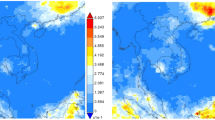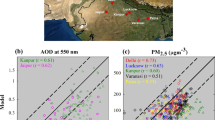Abstract
During the dry season, from November to April, agricultural biomass burning and forest fires especially from March to late April in mainland Southeast Asian countries of Myanmar, Thailand, Laos and Vietnam frequently cause severe particulate pollution not only in the local areas but also across the whole region and beyond due to the prevailing meteorological conditions. Recently, the BASE-ASIA (Biomass-burning Aerosols in South East Asia: Smoke Impact Assessment) and 7-SEAS (7-South-East Asian Studies) studies have provided detailed analysis and important understandings of the transport of pollutants, in particular, the aerosols and their characteristics across the region due to biomass burning in Southeast Asia (SEA). Following these studies, in this paper, we study the transport of particulate air pollution across the peninsular region of SEA and beyond during the March 2014 burning period using meteorological modelling approach and available ground-based and satellite measurements to ascertain the extent of the aerosol pollution and transport in the region of this particular event. The results show that the air pollutants from SEA biomass burning in March 2014 were transported at high altitude to southern China, Hong Kong, Taiwan and beyond as has been highlighted in the BASE-ASIA and 7-SEAS studies. There are strong evidences that the biomass burning in SEA especially in mid-March 2014 has not only caused widespread high particle pollution in Thailand (especially the northern region where most of the fires occurred) but also impacted on the air quality in Hong Kong as measured at the ground-based stations and in LulinC (Taiwan) where a remote background monitoring station is located.




















Similar content being viewed by others
References
Chen, T., Yen, M., Huang, W., et al. (2002). An East-Asian cold surge: case study. Monthly Weather Review, 130, 2271–2291.
Cheng, F.-Y., Yang, Z.-M., Ou-Yang, C.-F., & Ngan, F. (2013). A numerical study of the dependence of long-range transport of CO to a mountain station in Taiwan on synoptic weather patterns during the Southeast Asia biomass-burning season. Atmos. Envir, 28, 277–290.
Draxler, R., & Hess, G. (1998). An overview of the HYSPLIT_4 modeling system of trajectories, dispersion, and deposition. Aust. Meteor. Mag., 47, 295–308.
Engling, G., Zhang, Y. N., Chan, C. Y., et al. (2011). Characterization and sources of aerosol particles over the southeastern Tibetan Plateau during the Southeast Asia biomass-burning season. Tellus B, 63(1), 117–128.
Fiebig, A., Lunder, C., & Stohl, A. (2009). Tracing biomass burning aerosol from South America to Troll Research Station, Antarctica. Geophys. Res. Let., 36, L14815. doi:10.1029/2009GL038531.
Forster, C., Wandinger, U., Wotawa, G., et al. (2001). Transport of boreal forest fire emissions from Canada to Europe. Journal of Geophysical Research, 106(22887–22906), 2001. doi:10.1029/2001JD900115.
Gautam, R., Hsu, N. C., Eck, T., et al. (2013). Characterization of aerosols over the Indochina peninsular from satellite-surface observation during biomass burning pre-monsoon season. Atmos. Envir., 78, 51–59.
Gebhart, G. (2014), Transboundary pollution in Northern Thailand causes dangerous levels of smog, Asia Foundation, http://asiafoundation.org/in-asia/2014/03/26/transboundary-pollution-in-northern-thailand-causes-dangerous-levels-of-smog/
Huang, K., Fu, J., Hsu, C., et al. (2013). Impact assessment of biomass burning on air quality in Southeast and East Asia during BASE-ASIA. Atmos. Envir., 78, 291–302.
Kaufman, Ỵ., Tanre, D., & Boucher, O. (2002). A satellite view of aerosols in the climate system, Nature, Vol. 419(12). Sept., 2002, 215–223.
Lawrence, M., & Lelieveld, J. (2010). Atmospheric pollutant outflow from southern Asia: a review. Atmospheric Chemistry and Physics, 10, 10017–11096. doi:10.5194/acp-10-11017-2010.
Lin, N., Tsay, S., Maring, H., et al. (2013). An overview of regional experiments on biomass burning aerosols and related pollutants in Southeast Asia: from BASE-ASIA and the Dongsha Experiment to 7-SEAS. Atmos. Envir., 78, 1–19.
Meteorological Service Singapore (2014), Update of regional weather and smoke haze for May 2014, http://www.weather.gov.sg/wip/pp/ssops/reparch/may14.pdf
Omar, A., Winker, D., Vaughan, M., et al., (2009), The CALIPSO automated aerosol classification and lidar ratio selection algorithm. J. Atmos. Oceanic Technol., 26, 1994–2014, doi: http://dx.doi.org/10.1175/2009JTECHA1231.1
Ou-Yang, C., Hsieh, H., Wang, S., et al. (2013). Influence of Asian continental outflow on the regional background ozone level in northern South China Sea. Atmos. Envir., 78, 144–153.
Park, M., Song, C., Park, R., et al. (2013), New approach to monitor transboundary particulate pollution over northeast Asia, Atmos. Chem. Phys. Discuss., 13, 15867–15905, www.atmos-chem-phys-discuss.net/13/15867/2013/doi:10.5194/acpd-13-15867-2013
Rolph, G., Draxler, R., Stein, A., et al. (2009). Description and verification of the NOAA smoke forecasting system: the 2007 fire season. Weather and Forecasting, 24, 361–378.
Sang, X., Zhang, Z., et al. (2013). Source categories and contribution of biomass smoke to organic aerosol over the southeastern Tibetan Plateau. Atmos. Envir., 78, 113–123.
Shi, Y., Sasai, T., & Yamaguchi, Y. (2014). Spatio-temporal evaluation of carbon emissions from biomass burning in Southeast Asia during the period 2001–2010. Ecological Modelling, 272, 98–115.
Stohl, A., & Trickl, T. (1999). A textbook example of long-range transport: simultaneous observation of ozone maxima of stratospheric and North American origin in the free troposphere over Europe. Journal of Geophysical Research, 104(30445–30462), 1999.
Stohl, A., Berg, T., Burkhart, J., et al. (2007). Arctic smoke: record high air pollution levels in the European Arctic due to agricultural fires in Eastern Europe in spring 2006. Atmospheric Chemistry and Physics, 7, 511–534.
Sukitpaneenit, M. (2014). Nguyen Thi Kim Oanh (2014), satellite monitoring for carbon monoxide and particulate matter during forest fire episodes in Northern Thailand. Environmental Monitoring and Assessment, 186(4), 2495–2504.
Tsai, Y., Soparajee, K., et al. (2013). Source indicators of biomass burning associated with inorganic salts and carboxylates in dry season ambient aerosol in Chiang Mai basin, Thailand. Atmos. Envir., 78, 93–104.
Tsay, S., Hsu, C., & Lau, W. (2013). From BASE-ASIA toward 7-SEAS: a satellite-surface perspective of boreal spring biomass-burning aerosols and clouds in Southeast-Asia. Atmos. Envir, 78, 20–34.
Wang, S., Tsay, S., Lin, N., et al. (2013). Origin, transport, and vertical distribution of atmospheric pollutants over the northern South China Sea during the 7-SEAS/Dongsha Experiment. Atmos. Envir, 78, 124–133.
Acknowledgments
The provision of air quality data from the Pollution Control Department (PCD) of Thailand, the Environmental Protection Department of Hong Kong SAR, Professor N. Lin of National Central University (Chung-Li, Taiwan) and the Environmental Protection Administration (EPA) of Taiwan is gratefully acknowledged.
Analyses and visualizations, where they are indicated in the paper, were produced with the Giovanni online data system, developed and maintained by the NASA GES DISC, and CALIPSO satellite products from NASA Langley Research Center. We also acknowledge the NOAA Air Resources Laboratory (ARL) for the provision of the HYSPLIT transport and dispersion model and/or READY website (http://www.ready.noaa.gov) used in this publication.
Author information
Authors and Affiliations
Corresponding author
Ethics declarations
Conflict of interest
The authors declare that they have no competing interests.
Rights and permissions
About this article
Cite this article
Duc, H.N., Bang, H.Q. & Quang, N.X. Modelling and prediction of air pollutant transport during the 2014 biomass burning and forest fires in peninsular Southeast Asia. Environ Monit Assess 188, 106 (2016). https://doi.org/10.1007/s10661-016-5106-9
Received:
Accepted:
Published:
DOI: https://doi.org/10.1007/s10661-016-5106-9




